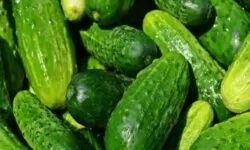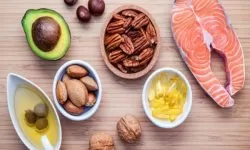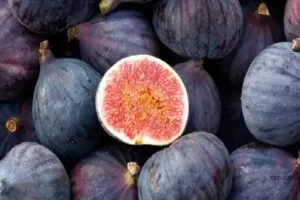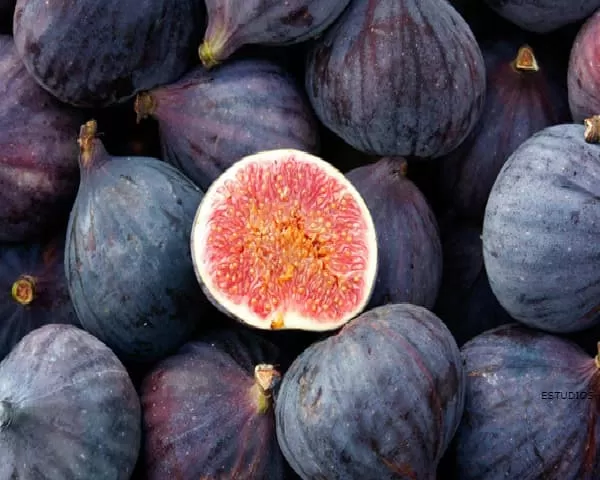The fig is considered by many people to be a false fruit, which is a receptacle, containing an infinite number of small fruits, commonly being seeds or pips one on top of the other. Its use is mostly as a fresh fruit, also, it can be ingested in a dried way, as different purees for confectionery, jellies, jams, among others.
Figs, in general terms, turn out to be extremely fragile fruits, so their conservation needs to be much more careful compared to many fruits. Since it is a totally perishable fruit, a fully ripe fig cannot spend more than 3 days in the refrigerator or it will rot. The fig is a fruit with a high content of fiber, which makes it an ideal food for all those who wish to improve their intestinal transit in a healthy way. It is also a fruit that is good for digestion, avoiding stomach pains, possible constipation, acidity, among other things. Within the system of classification of fruits, the fig belongs to the following: fruits that provide the body with vitamins C, fruits that supply high levels of potassium, astringent fruits, fruits good for digestion, fruits rich in fiber, antioxidant fruits, fruits of the forest, fruits with vitamins A, among others.
Origin of the Fig
The main origin of the fig is given in Asia Minor, known today as Western Asia. As is often investigated, this fruit is given by the tree called fig tree, which is presumed to have been in existence for more than 9000 BC.
The fig can be obtained quickly in countries below the equator, mostly in the months of February and March, because they grow in widely temperate climates. However, for countries above the equator, figs tend to flower in the months of August and September. Nowadays, many people tend to confuse the fig with the breva, because it is a fig that did not manage to reach its state of maturity, mostly in its harvest period.
Properties of the Fig
Among the main nutritional properties of this wonderful fruit such as the fig, you get the following:
- Mainly they are characterized for being rich foods in water and carbohydrates, more than everything in glucose, fructose and sucrose, reason why it tends to be a fruit with highly elevated caloric value.
- It is a fruit that stands out for its fiber content, which improves intestinal transit, also, is responsible for providing different acids and minerals capable of representing high benefits for the human body in general.
- In the same way, it contributes with other minerals, among which the provitamins A stand out, which work as antioxidant actions for the human body; this vitamin is essential for the human body since it improves the vision, the good condition of the skin and the hair, as well as the mucous membranes and the bones in general.
- On the other hand, the potassium that it supplies is duly important for the transmission and generation of the nervous impulse, in the same way, it serves for all muscular activity in a normal way and finally, it helps to intervene in the water balance, both inside and outside the cell.
Among the main health properties of this incredible fruit like the fig, you get the following:
- Figs are highly rich in carbohydrates, which the body is responsible for transforming them into glucose, which is why figs are recommended by specialists for all people in general, particularly because they are responsible for providing extra energy levels, which are essential for everyday life in people.
- Thanks to the fiber that they provide, it is considered a highly laxative fruit, having the capacity to fix substances in the organism, be it bile acids, cholesterol, among others, and in the same way, diminishing or delaying the levels of absorption in the human body.
- On the other hand, figs are considered to be totally antioxidant fruits, so they help the human body in general to neutralize the harmful action of free radicals, contributing to reduce an infinite number of diseases, either cardiovascular, degenerative, and even possible cancers.
- Finally, thanks to its high potassium and low sodium content, the fig is a recommended food for all those who suffer from constant high blood pressure, or failing that, different blood vessel conditions.
Benefits of the Fig
Among the main benefits of figs, people get the following:
- Figs are mainly considered high-fiber foods, as well as good sources of several essential minerals for the human body, including potassium, magnesium, manganese and calcium, the latter promoting bone density.
- Figs help to reduce high blood pressure, so they are normally recommended to control the levels of the arteries, helping to reduce the risk of cardiovascular disease as well, thanks to their high potassium content.
- Figs help fight obesity, as it is a highly satiating fruit for the human body, preventing people from eating desserts or meals that they should not eat outside of their established schedule. This is achieved thanks to its extremely natural sugar content, which allows to calm the desire for sweets.
- Figs increase energy levels, since they help balance the levels of these substances, improving people’s moods. For this, the fig is a good source of natural sugars and helps you radically.
Types of Figs
Among the most prominent varieties of figs, people get the following:
Figs are mostly classified into three groups according to their color. The white figs are presented when they are in their time of maturity, interspersing the colors from whitish, through yellowish, to culminate in greenish tones.
Then there are the yellow figs throwing to golden, which include different types of crops, among them the blue-brown colors, being a little clear with the passage of time. The black varieties, on the other hand, include an infinite number of figs which have colors that range from dark reds to those that are completely black.
Also, figs can be classified according to different criteria, among them: according to their use, which are divided into two large groups, for fresh consumption or completely dried.
On the other hand, table figs are the ones most people consume, since they are totally fresh, their skin is tender, with few seeds inside and their ripening is long and extended. Dried figs have different skins, much more tenacious and whole, compared to other species of figs.
And because of their names, among the most outstanding varieties are the Brown Turkey figs, which grow mostly in Italy, the United States and Israel; they are fruits similar to pears, measuring 4 to 6 centimeters, being dark red in color.
You also get the light blue fig varieties, which come from Mexico and California, being available mostly in November, December and January. When the fruit is ripe, the skin turns purple, while the pulp remains light pink.
Fig Tree
This tree is called fig tree, and is a very fruity tree of the genus Ficus, originating mainly in Asia, and prolonged over the years to the Mediterranean area.
It turns out to be a tree with history, approximately from 4500 B.C., since the Egyptians collected it; it is a tree with more than 1000 species at the present time, and that normally is found in regions with warm and intertropical temperatures.
For its part, the growth of this fig tree involves many roots, which are exaggeratedly strong, and can break up both floors and walls, so it is considered a perfect tree to grow naturally in widely rocky terrain, and thus not cause problems around it.
It is a resistant tree, as much to adverse climatic conditions, like to the amount of culture that is around him. In the same way, it is a tree more or less medium, for which its height does not exceed 10 meters, the same one, possesses an extremely wide top, which is useful to give shade.
At present, there are three types of fig trees, which are called Smyrna figs, and these are pollinated by insects, specifically the fig wasp. Then, they get the common fig tree, which does not need pollination and finally, there is the intermediate fig tree, which does not need pollination either for the development of its brevas but for the cultivation of its fruit, which is the fig.
This tree, tends to bloom in the months of February, March and April, being its unisexual flowers, reunited in great numbers in comparison to other trees, these same ones go within a receptacle, completely piriforme, fleshy, which is called in botanical terms like sinoco.
Finally, it turns out to be an extremely rustic tree, resistant to both drought and salinity. It is often found in isolation, without being in the form of highly ordered plantations.
Does The Fig Get You Fat?
After having spoken in general terms about the properties and benefits of the fig, there is this question, and honestly, figs do not get fat, mainly because it is a food that helps promote the amount to be healthier in people.
In spite of being a fruit with high sugar content, it is a completely natural sugar, besides, it is in charge of supplying the human body with different components that make people not tend to get fat when they are consumed.
On the contrary, it is a fruit that helps in the digestion process, so it contributes in a direct way to the constant reduced weight loss.
Does Fig Have Fiber ?
Figs are rich in fiber, providing a total of 3 grams per 100 grams of edible portion, being its nutritional characteristic most remarkable, within them prevail both soluble and insoluble fibers.
Because figs are high in dietary fiber, they are considered a perfect food for all those who wish to lose weight in a healthy way. A secret is that all foods containing more fiber, makes people feel totally full and reduces the levels of cravings that make you fat.
Does Fig Have Sugar ?
Figs have high amounts of water, and although they are rich in sugars, they are ideal foods to consume frequently on a daily basis, obviously calculating the portions that people will consume since everything in large quantities can be harmful to health in general.
In total, figs provide 15 grams of sugar to the human body, making them one of the fruits with the highest level of sugar, being these fructose, glucose and sucrose. Being a fruit with a high carbohydrate content, they are mostly recommended for people who constantly perform physical activities, including athletes.
Does the Fig Make you Fat if you Eat it at Night?
Figs are mainly characterized by being ideal foods to include in slimming diets, mostly because its low sugar level does not harm health in general.
For this reason, the fig is a fruit that does not make people fat if consumed properly, and in this, will not affect either, if people come to eat it either at night or during the day, because its properties are never changed at the time of consumption, on the contrary, always has different advantages thanks to the amount of nutrients, vitamins and minerals provided constantly.
Is the Fig Diuretic ?
For its high content in potassium, and its notorious contributions in nutrients like the soluble and insoluble fiber, it makes the fig a highly diuretic or depurative fruit extremely natural, so it will help people not to retain unwanted liquids in the blood and to expel them through the urinary system in a normal and constant way.
Is the Fig Good for Digestion ?
Thanks to the soluble fibers that the fig supplies to the human body, it helps control the levels of cholesterol found in the blood, as well as glucose, both of which contribute to regulating the intestinal transit of the stomach.
On the other hand, insoluble fibers help to facilitate all intestinal transit, having preventive effects when contracting different diseases such as colon cancer.
Does the Fig Get You Thinner ?
Despite the fact that the fig contains a widely sweet flavor, it is a fruit that does not turn out to be caloric for the human body, besides, it perceives other components that help people to lose weight, among them the fiber, which works as a satiating effect for the organism.
On the other hand, the composition of the fig is approximately 85% water and about 20% carbohydrates, so it is an ideal fruit to include in slimming diets, since it fulfills essential functions for people to lose weight regularly.
Fig Calories
Within the composition of 100 grams consumed per day of figs this fruit provides a total of 66 calories to the human body, distributed in 16 grams of carbohydrates, 2.5 grams of fiber, 235 milligrams in potassium, 20 milligrams in magnesium, 38 milligrams of calcium, 3.5 milligrams of vitamins C and 25 micrograms of provitamin A.
History of the Fig
The fig is a fruit that has been part of the diet of many inhabitants since ancient times. Mainly, in Egypt, specifically in the pyramid of Gizeh, more than 5000 B.C., where drawings were found representing its cultivation harvest. On the other hand, in the book of Exodus this fruit was part, as one of the main foods that Canaan presented to Moses.
Figs have always been an essential and indispensable food for the Greeks; from fig trees they consecrated themselves to Dionysus, who was the God of Renewal. Another story states that when a city was founded, a fig tree was planted between the agora and the forum in order to point out exactly the place where the elders were constantly meeting.
On the other hand, the fig was Plato’s favorite delicacy, which is why it is known today as the fruit of the philosophers. Similarly, Galen constantly recommended this fruit to the athletes who participated in different Olympic games.
Many stories fall on the fact that the fig originated in the Mediterranean, so this fruit is very precious in those areas, where it has transcended over the years, in different cultures, especially those found on the shores of the sea.
Among the countries that produce figs, Spain, Greece, Turkey, United States, Brazil, Israel, Holland, Poland, New Zealand, Italy, France, Germany, Chile and South Africa stand out.
Topics Related to Fruits in ALPHAPEDIA

APRICOT: Properties, Benefits and Their Contraindications

PEAR: Properties, Benefits and Types. Astringent or Depurative ?

PERSIMMON: Origin, Properties and Benefits

💚 THE GRAPE: Properties, Origin and Benefits

RASPBERRIES: Origin, Properties and Benefits

CUCUMBER: Fruit or Vegetable. Benefits and Properties
Health and Wellness Issues at ALPHAPEDIA

PERSIMMON: Origin, Properties and Benefits

LOQUAT: Properties and Benefis. What Is It For ?

RICE OR SWEET POTATO

COCONUT: Benefits, Properties and Contraindications

💚 WHAT IS THE OMEGA 3 GOOD FOR ? Benefits and Properties

RASPBERRIES: Origin, Properties and Benefits
Other Topics of Interest in ALPHAPEDIA

SPAIN: Map, Provinces and Cities

FREE MASSAGE COURSE

FREE HOTEL RECEPTIONIST COURSE

CELL PHONE DEFINITION

FREE BACHELOR DEGREE IN PHYSICS

FREE SOCIAL NETWORKS COURSE
Image of the FIG



